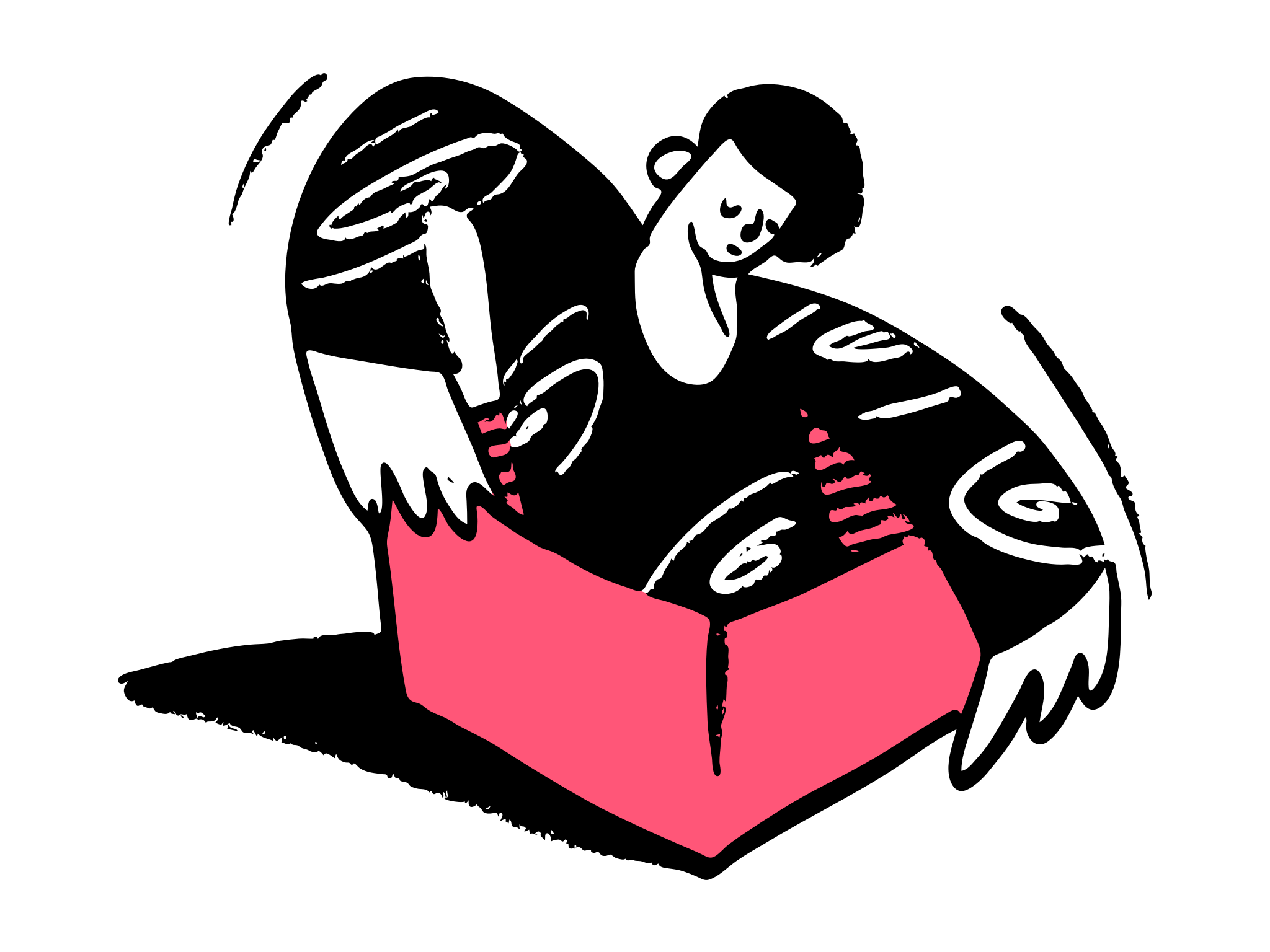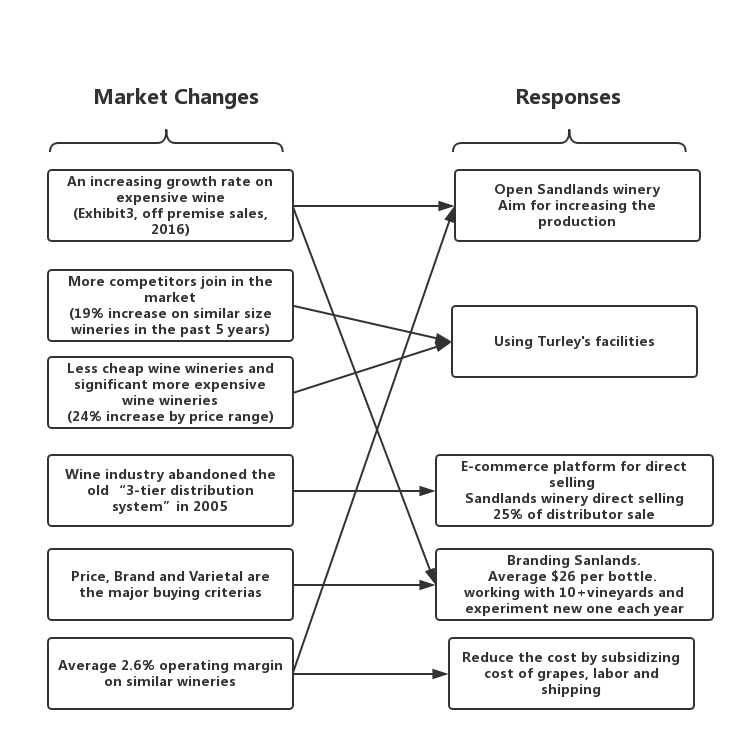What is blue ocean strategy and how can you create one? (Case Study)
Table of Contents (Click to show/hide)









Blue Ocean Strategy Case Study: Sandlands Vineyard
1.0 Introduction
Created by Tegan Passalacqua, “Sandlands” has become one of the most inventoried wine brands in the U.S market. With its competition challenges and business difficulties, Tegan Passalacqua managed to develop this brand by applying segmentation, analysing the current market and implanting a developing strategy. This case study will be working on its matching plan and offer a strategic analysis based on segmentation, consumer change, competitive responses and prioritisation of limited resources. Further investigation will be given to analyse the investment decision. Recommendations will be presented below.
2.0 Strategic Analysis
The U.S wine market is intensely competitive (Refer to Exhibit 2). There were more than 9000 wineries in the U.S by 2017. However, with its business model (Exhibit 1), Sandlands still succeeds in making a profit and being able to make an investment in this situation.
In 2005, the wine industry abandoned the old “3-tier distribution system” and applied a new way - wine producers are able to sell wine to retailers and customers. According to Esty B & Saldutte G (2018), wine is an everyday consumption as it’s for daily table use in U.S culture. However, only 15% in the alcoholic beverage’s market is counted for the wine industry.
In the customer segments survey (Esty & Saldutte, 2018), drinking habits is a crucial segmentation in the wine market. More than 70% of surveyed drinkers considered price and brand are the most critical factors for their purchasing decision. A significant profit (almost 62%) is heavily influenced by these two factors. Furthermore, there are approximately 70% of the market share in wine accounts for low-pricing range. It reveals the price war, and a niche opportunity – premium wine.


2.1 Segmentation
To position Sandlands in the U.S wine marketing, a SWOT analysis (Exhibit 3) should be conducted to pinpoint its advantages and shortcomings.

As a small local winemaker facing the competition of domestic competitors and imported products, Sandlands vineyard should be only targeting the domestic market. According to the Esty B & Saldutte G (2018), Sandlands primary customer will be the return customer who purchases wine yearly, followed by the highest-frequent buyer. The newcomers will come at last (Exhibit 4).

With that in mind, a consumer profile can be created.

2.2 Consumer Change
The Wine market share in U.S alcohol market is limited(Appendix 3). According to the case study (Esty & Saldutte, 2018), selling points of the existing product can be seen in their purchase criteria (Exhibit 6).
Only 40% of people choose the wine in U.S alcoholic beverage market, and 80% of wine consumption and the purchase is accounted for high-frequency drinkers. However, 80% of adults have purchased wine above $50 per bottle.

Sandlands is now facing a consumer change in the wine market – consumers see price and brand as the primary purchase factors. However, the price indicates the wine quality. No connection is detected between price and taste among frequent-drinkers (Esty & Saldutte, 2018). As such, the “premium flavour” that Sandlands vineyard is proud of is not absolute advantage. The low-price range of wine has a decreasing performance trend in off-premise channels. Meanwhile, customers prefer to purchasing expensive wine directly from the winery. This also indicates that middle-to-high price range wine has better performance on off-premise sale, and it is getting heated in the overall market.
2.3 Competitive Responses
Sandlands made some changes accordingly to respond to the market status (Exhibit 7):
- a) Flavour and quality come first, and more brands have been found to adapt to the market.
- b) Winery investment to avoid the high vineyard maintenance cost, low productions and inconsistent taste.
- c) Distribute in B2B and B2C channels to compete with the budget wine and maximum the margin and market influence.

2.4 Prioritisation of Limited Resources
As a small team,Sandlands has limited resources. So, it focuses on three critical goals as its business priorities: increase the verities, lower the cost and enjoy contemporary wine-making. So relatively actions are put into place:
- a) Old-vineyards are more preferable as they have less business with large companies.
- b) Costs will be reduced, and production will be increased by investing in a winery.
- c) “Family members only” to avoid the extra labour cost.
3.0 Strategy Frameworks Analysis and Recommended Strategies
The 4 perspectives of balanced scorecard have the following purposes: the activities between the critical factors of business success have been required to be “balanced”. It also serves as a framework for communicating the strategy of an organisation like Sandlands to broader stakeholders.

Based on the balanced scorecard framework, we can manage to create a status report for Sandlands' brand.
4.0 Balanced Scorecard

5.0 Results and Recommendation
5.1 Corporate level strategy
For Passalacqua, the overall goal is to manage the whole wine-making process from grape collection to wine distribution. He wants to increase production to 5000 cases per year and create an integrated supply chain. The U.S wine market is already a red ocean market with domestic and international competitors. Sandlands should identify the edge of this market and apply a blue ocean strategy. Sandlands should establish a winery tourism program for his business. The economic influence of wine tourism is remarkable (Refer to the information below). The motivation in the wine tourism industry includes cultural landing places that related to wine (Alant & Bruwer, 2004). Combine with the current market and his business framework, his advantages are also his opportunity.
In California, US$2.1 billion has been spent by 20.7 million tourists that wine regions hosted in 2009. In 2004, wine tourism contributed US$75 million to the economy of Michigan, drove 800,000 visitors to North Carolina in 2005, and was tied to 40% of all hotel revenue in Walla Walla, Washington, in 2007

5.2 Recommendations
According to Quadri-Felitti & Fiore (2012), The U.S tourism market has been made a remarkable economic contribution (Appendix 2). As a vineyard owner, Tegan’s passion and interest are primary in wine-making, which means the sourcing and production are what he should focus on. A winery investment is a good strategy. Therefore, once the winery production is completed, he should shift its priority into an alternative industry as a side business– Create a hospitality business in his winery. More attention should be paid to branding and marketing. According to Alant & Bruwer (2004), The motivation for both first‐time and return visitors are similar - experiencing and learning the wine-making process from the start to the end. This understanding of contemporary wine-making is what Tegan is good at.
The primary profit is coming from the direct selling channel. By using digital marketing to shift marketing responsibility from the distributors to the owner himself will save the cost and increase the profit. Furthermore, A full understanding of purchase factors is required:
- people who buy wine are mostly for special occasions;
- people who buy the premium wine are more likely to go to the winery instead of wine shops (Esty & Saldutte, 2018).
Interaction in the community plays a crucial part in participation. An increasing desire for affiliation signifies a better chance of satisfaction and more frequent communication (Tsai, Huang & Chiu, 2012). Establish a winery tour and utilise e-commerce platform and apply sales promotion base on events schedule will boost the overall profit.
Communities are more likely gathered in particular places, occasions which has a localised feature. Their interactions, information exchange, and awareness will boost the brand centralisation (Marshall, Cordano & Silverman, 2005). User-generated content is a crucial element of marketing and the increasing face to face interaction and fulfilment of wine knowledge-affiliation in the winery experience tour will help lift the business image, hence the brand awareness. Brand, varietal and label are in the top five wine buying criteria (Esty & Saldutte, 2018). By setting a winery tour with the retail price of $26 will be a benefit to the brand and overall sales.
6.0 Conclusion
With the information presented above, the Sandlands has successfully mirrored business strategy framework and marketing theories. It brings individual needs into completion by creating unique product selling points. Sandlands illustrates how a brand embeds into the local culture and commits to this long-term relationship. By identifying the problems and engaging the blue ocean strategy, it is no doubt that Sandlands will become an active agent for building a trusted wine-culture relationship.
Reference List
- Alant, K., & Bruwer, J. (2004). Wine tourism behaviour in the context of a motivational framework for wine regions and cellar doors. Journal of Wine Research, 15(1), 27-37.
- Esty, Benjamin C., and Gregory Saldutte. "Sandlands Vineyards." Harvard Business School Case 718-438, February 2018. (Revised March 2018.)
- Marshall, R. S., Cordano, M., & Silverman, M. (2005). Exploring individual and institutional drivers of proactive environmentalism in the US wine industry. Business Strategy and the Environment, 14(2), 92-109.
- Quadri-Felitti, D., & Fiore, A. M. (2012). Experience economy constructs as a framework for understanding wine tourism. Journal of Vacation Marketing, 18(1), 3-15.
- Tsai, H. T., Huang, H. C., & Chiu, Y. L. (2012). Brand community participation in Taiwan: Examining the roles of individual-, group-, and relationship-level antecedents. Journal of Business Research, 65(5), 676-684.
- Wang, Y., & Fesenmaier, D. R. (2004). Modeling participation in an online travel community. JOURNAL OF TRAVEL RESEARCH, 42(3), 261-270.
Appendix
l Appendix 1
With the changed system in 2005, the wine industry abandoned the old “3-tier distribution system” and applied a new way - wine producers are able to sell wine to retailers and customers. According to Esty B & Saldutte G (2018), wine is an everyday consumption as it’s for daily table use in U.S culture. However, only 15% in the alcoholic beverage’s market is counted for the wine industry.
In the customer segments survey (Esty & Saldutte, 2018), drinking habits is a crucial segmentation in the wine market. More than 70% of surveyed drinkers considered price and brand are the most critical factors for their purchasing decision. A significant profit (almost 62%) is heavily influenced by these two factors which indicate that customers are more comfortable to convert. On the other hand, there are approximately 70% of the market share in wine accounts for low-pricing range. It represents the intense pricing competition, and a niches market opportunity – premium wine.
l Appendix 2
In California, US$2.1 billion has been spent by 20.7 million tourists that wine regions hosted in 2009. In 2004, wine tourism contributed US$75 million to the economy of Michigan, drove 800,000 visitors to North Carolina in 2005, and was tied to 40% of all hotel revenue in Walla Walla, Washington, in 2007
l Appendix 3
Only 40% of people choose the wine in U.S alcoholic beverage market and 80% of wine consumption and purchase are accounted from high-frequency drinkers. However, 80% of adults have purchased wine above $50 per bottle.









